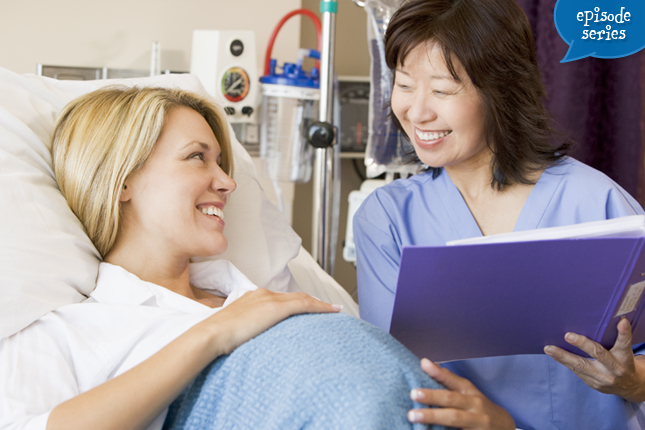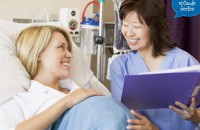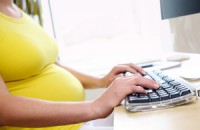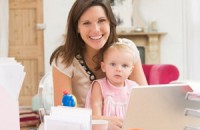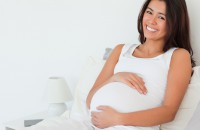Preggie Pals
Fetal Development: The Second Trimester.
[00:00:00]
Please be advised, this transcription was performed from a company independent of New Mommy Media, LLC. As such, translation was required which may alter the accuracy of the transcription.
[Theme Music]
DR. FRANK GOICEOCHEA: If you have gotten pass the morning sickness and you are in your golden trimester. Your baby’s developing rapidly and you have lots more appointments with your care provider. Today we’re going to be talking about the second trimester of pregnancy and all the exciting things that are going to happen with you and your baby. I’m Dr. Goiceochea, a board certified OBGYN and this is Preggie Pals episode 101.
[Theme Music/Intro]
ANNIE LAIRD: Welcome to Preggie Pals broadcasting from the birth education centre of San Diego. Preggie Pals is your weekly online on the go support group for expecting parents and those hoping to become pregnant. I’m your host Annie Laird. Thanks to all of our loyal listeners who’ve joined the Preggie Pals club. Our members get special episodes, bonus content after each show plus special giveaways and discounts. See our website for more information. Another way for you to stay connected is by downloading our free Preggie Pals app. This is available both in the Android market place and the iTunes market place. I’m here with Samantha, she’s our brand new producer and she’s going to be giving us some information about our virtual panellist program. So take it away Samantha.
SAMANTHA EKLUND: Thank you so much Annie. So if you don’t live in San Diego but you’d like to be a panellist on our show, you can still participate through our virtual panellist program. Just like us on Facebook and follow us on Twitter using #preggiepalsvp. We’ll post questions throughout the week prior to our taping and we’d love for you to comment so we can incorporate your thoughts into our episode. You can also submit your questions directly to our experts. Learn more about our virtual panellist program through the community section on our website www.preggiepals.com.
ANNIE LAIRD: Alright just a little bit more about myself and the producer today, I’m Annie. I’m 35, government contractor by day and kind of a labour doula, started to get back into that a little bit so and then podcast, host, blogger. Don’t have a due date. I have 3 little girls, a grade-schooler, a toddler and then my I don’t know if I can call her my newborn. Can I call her a newborn when she’s 20 pounds? I don’t know. They’re just big and just like to eat a lot. So yeah so vaginal birth for all my kids, so one in the hospital, one the home birth that transferred to the hospital, that was a load of fun and then the last one was a home birth so that’s me in the nutshell. So Samantha what about you?
SAMANTHA EKLUND: Alright so I’m Samantha. I’m 22. I’m a barista by morning and…
ANNIE LAIRD: You were at the Coffee Bean?
SAMANTHA EKLUND: I am with the Coffee Bean.
ANNIE LAIRD: Yeah.
SAMANTHA EKLUND: And a producer by afternoon. I do not have a due date although I wish I did. I have one little girl. She’s going to be 18 months and she’s already beginning into the terrible twos.
ANNIE LAIRD: What’s the month of her birthday?
SAMANTHA EKLUND: She’s born October 2012.
ANNIE LAIRD: Okay, alright. So she’s a little bit, she’s a little bit younger than my Lucy. That’s a fun age so because they start… she’s a pistol.
SAMANTHA EKLUND: Yeah.
ANNIE LAIRD: That’s a positive spin on that so. You know but it’s funny because the, they start to learn a lot more words around that age. So…
SAMANTHA EKLUND: Yes, that’s the best part.
ANNIE LAIRD: Yeah the best.
SAMANTHA EKLUND: And she was an unexpected caesarean so I’m hoping for a VBAC next summer.
ANNIE LAIRD: Oh awesome.
[Theme Music]
ANNIE LAIRD: Well let’s go in to our featured segment and this goes really well with what you were saying about your labour Samantha. Its New Jersey mom gives birth on a nail salon. So you do not give birth on a nail salon.
SAMANTHA EKLUND: No. No.
ANNIE LAIRD: You had 26 hours, 26 or 29, 26?
SAMANTHA EKLUND: 29.
ANNIE LAIRD: 29 hours of labour, wow. So Sergei Rubinstein, she’s a, had her newborn Damien in a nail salon. So I guess her first born here, she had him, oh I’m sorry she had her, a little girl, 3 years previously. It was a you know typical kind of first long labour and all that and I guess it took more than a day so she thought, well I’m not going to go you know and hang out at the hospital so she decided to get a manicure.
SAMANTHA EKLUND: So she’s was already in on early labour and decided…
ANNIE LAIRD: Yeah. She was on early labour you know and so she decided to go to the nail salon and her labour produce quickly after she got the manicure. I guess she want also to get a massage, a manicure and a pedicure but her husband got summoned to the salon as was an ambulance. And Sergei, her husband just came in time and the baby was born in a bathroom of the nail salon.
SAMANTHA EKLUND: Oh god.
ANNIE LAIRD: Yeah so you hope that their using the barber side right. The salon’s owner Nancy Wang, she was in route to the salon during the delivery. When she arrived, the baby was already born, she was still sitting in the bathroom for some reason and then very shortly after that the ambulance came. But she says that everybody was very nervous, I was happy the baby was born and was doing fine. So you know Samantha maybe that is you know a way to get a labour going.
SAMANTHA EKLUND: Exactly.
ANNIE LAIRD: Yeah and you know it was funny because I had friends you know they went and got a facial. A very good friend of mine she decided well you know maybe I think today is the day I’m going to go and get a facial and she barely made it home …
SAMANTHA EKLUND: Wow.
ANNIE LAIRD: And you know the birth photographer was also another dear friend of mine showed at the house and she was the first one. She was the first one to get there even before the husband was so and there’s something about you know just treating yourself and pampering yourself.
SAMANTHA EKLUND: There you go.
ANNIE LAIRD: Or maybe to you know a second baby. I mean my second baby I think that took me a little bit by surprise. You know by the time…
SAMANTHA EKLUND: Really.
ANNIE LAIRD: Yeah fast second babies so there you go. So lessoned learn from New Jersey mom from Anna Rubenstein in New Jersey. Go to the nail salon if you want to have a quick second birth.
[Theme Music]
ANNIE LAIRD: Today on Preggie Pals we are continuing our series on fetal development moving on to the second trimester. So first, if you remember we had an episode about this earlier on a few months ago and it was we kicked it off with the first trimester. So it was a lot of hey had this how you do with morning sickness, here’s all of the stuff that is going on with your baby and the development. So now we are moving on to the second trimester so our expert is Dr. Goiceochea and he works with Sharp Grossmont Hospital. He’s previously served as the hospital’s OBGYN department chairman. Dr. Goiceochea, welcome to the show thanks for joining us.
DR. FRANK GOICEOCHEA: Thank you for inviting me. Thank you.
ANNIE LAIRD: Yeah so what, talking about the second trimester, what weeks of pregnancy usually correlate with the second trimester?
DR. FRANK GOICEOCHEA: Usually the start during 13 to 26 weeks.
ANNIE LAIRD: Yeah.
DR. FRANK GOICEOCHEA: When you say that we count from the first day of the last period…
ANNIE LAIRD: Okay.
DR. FRANK GOICEOCHEA: [inaudible] for two so for the last, the next two weeks. It’s a lot of confusion but usually, it’s around 13 to 26 weeks.
ANNIE LAIRD: Oh okay. So that yeah that’s about months for the 4 to 6.
DR. FRANK GOICEOCHEA: 4 to 6 correct.
ANNIE LAIRD: Yeah. And so it’s funny because sometimes you’ll go on websites, at least I did when I was pregnant, like baby center I don’t know Samantha if you know that.
SAMANTHA EKLUND: Oh of course.
ANNIE LAIRD: Yeah and you’re like you know and it’s tough because with that first trimester, I think a lot of women don’t tell. Maybe you know they probably tell their partner but not a lot about the people work and whatnot.
SAMANTHA EKLUND: And friends.
ANNIE LAIRD: I’m going to get out of my first trimester and get into the second trimester so I know the pregnancy is solid, the baby is good, the baby is healthy, you know and so for someone…
SAMANTHA EKLUND: You go and tell in social media or anything.
ANNIE LAIRD: Yeah.
SAMANTHA EKLUND: Ain’t that right.
ANNIE LAIRD: Yeah. Well some people do.
SAMANTHA EKLUND: Right.
ANNIE LAIRD: Some people do, some people don’t but yeah you know you want to wait until the end of the first trimester but it’s confusing sometimes. You go into this websites you know like when is, is it like 12 weeks? Is it 14 weeks?
SAMANTHA EKLUND: Is it 12 weeks or 14 weeks?
ANNIE LAIRD: I don’t know. Yeah so doctor what percentage of women get relief from morning sickness during the second trimester?
DR. FRANK GOICEOCHEA: Well over 50%.
ANNIE LAIRD: Oh that’s great.
DR. FRANK GOICEOCHEA: Yeah that’s a big change.
ANNIE LAIRD: Yeah I would say my friend, Cherry, she just had her baby I was just showing her pictures before we started taping here to Samantha and she had terrible morning sickness. I’m trying to think what’s the term for when you have to throw on the whole pregnancy? Hyper something…
DR. FRANK GOICEOCHEA: Hyperemesis gravidarum.
ANNIE LAIRD: Yeah. Yeah so she had that throughout her pregnancy so…
DR. FRANK GOICEOCHEA: They’re pretty miserable.
ANNIE LAIRD: Yeah.
DR. FRANK GOICEOCHEA: The doctors centres are pretty miserable too.
ANNIE LAIRD: Yeah. I only had morning sickness really in my first trimester and that was bad enough. It was the worst for I know. Samantha did you have it early?
SAMANTHA EKLUND: I did 6 to 12 weeks. Those 6 weeks were miserable.
ANNIE LAIRD: Yeah.
SAMANTHA EKLUND: But you know I didn’t have morning sickness. I had afternoon sickness. It was like 2pm through the rest of the day. Morning was fantastic so I get everything done I needed to do during the morning.
ANNIE LAIRD: Were you working at the Coffee Bean on that time?
SAMANTHA EKLUND: I still was.
ANNIE LAIRD: Yeah.
SAMANTHA EKLUND: Luckily I was the morning shift because 2pm the rest of the day I was out.
ANNIE LAIRD: Yeah.
DR. FRANK GOICEOCHEA: That’s [inaudible] you’re right. It’s not the mornings we more call nausea of pregnancy.
ANNIE LAIRD: Yeah.
DR. FRANK GOICEOCHEA: Rather than the morning sickness because it can happen any time. And often can be in the afternoon that can be hard.
SAMANTHA EKLUND: Yes.
ANNIE LAIRD: Now and you mention to 12 weeks and for me it was yeah it was 12, 13 weeks and all of a sudden it was like the clouds parted and like.
SAMANTHA EKLUND: Your belly starts showing.
ANNIE LAIRD: Exactly yeah. Yes I feel great.
SAMANTHA EKLUND: Yeah exactly.
ANNIE LAIRD: Now I mean what causes that big shift? Why do so many get that relief in their second trimester?
DR. FRANK GOICEOCHEA: Well if we go as, if we can try to ask what causes it? For some of you who don’t know, we think that is a combination of hormones produced in the placenta. The [inaudible] that is the hormone that is produce in high levels during the second trimester during the first trimester. High levels of estrogen and you get done with the birth control pills you get nauseated. High levels progesterone. All this happen more in the first trimester. Second trimester begin to come down.
ANNIE LAIRD: Oh okay.
DR. FRANK GOICEOCHEA: So I would think that if you’re going to think that the elevation causes the morning sickness and it started coming down then you get a relief with that. Also some psycho socio involvement in it and there is also maybe improvement on that are also makes improvement on the nausea and the morning sickness so to speak.
ANNIE LAIRD: Yeah I mean that was one thing during the morning sickness of like my first trimester that was the only thing that I had was you know what at least this is probably in like you’re saying it’s all lot this hormones this elevated level during my first trimester so that was the only thing I held on to like you know what I’m going to be grateful that I’m sick especially since I had several loses in between my first and my second pregnancy, 3 of them. They said you know I’m just going to hold on to the fact that this means that this is ....
SAMANTHA EKLUND: It’s encouraging.
ANNIE LAIRD: Yeah. That it’s a healthy baby that the pregnancy going to stick this time and it did. Yeah so she’s free, large and pretty wild now. Yeah so I’m grateful. When is the sex of the baby apparent? Is that something that you can tell by ultrasound right at the beginning of the second trimester or…
DR. FRANK GOICEOCHEA: So much in the fourteen weeks you can get it.
ANNIE LAIRD: Yeah.
DR. FRANK GOICEOCHEA: Yeah. You can because probably it takes a lot of time especially if [inaudible].
ANNIE LAIRD: Yeah.
DR. FRANK GOICEOCHEA: [inaudible] very shy
ANNIE LAIRD: Hi mom yeah.
DR. FRANK GOICEOCHEA: Right, here it is for you. Usually around that times you can tell.
ANNIE LAIRD: Yeah. Now and if a woman is getting like an amniocentesis or something like that they would definitely be able to tell like I don’t know what to say like 100% but that would be a better indicator than if like an ultrasound is that correct?
DR. FRANK GOICEOCHEA: If you do the amnio as opposed to the ultrasound?
ANNIE LAIRD: Yeah.
DR. FRANK GOICEOCHEA: When you do the amnio in general you do it for chromosomal studies.
ANNIE LAIRD: Right.
DR. FRANK GOICEOCHEA: And then definitely you get the chromosomes there.
ANNIE LAIRD: Yeah. So yeah you definitely know if it’s a boy or it’s a girl as opposed to you know having a surprise with an ultrasound. So but I imagine yeah earlier on you know there’s just less baby you know the baby is not quite as big in right at the beginning in the second trimester as opposed because I know Samantha when did you have your ultrasound? Or did you have multiple ultrasounds?
SAMANTHA EKLUND: So I was that mom that paid to go get an ultrasound like as soon as you could.
ANNIE LAIRD: Yeah.
SAMANTHA EKLUND: To find out what it was. But I already had a really good intuition. I told everybody else I was like I already started paying stuff like I already know it’s going to be a girl and then a month later they were like yeah it’s a girl so…
ANNIE LAIRD: Yeah.
SAMANTHA EKLUND: But next time we don’t plan on finding out so I’m kind of on both ends of the spectrum.
ANNIE LAIRD: Yeah you know and I’d like to talk with that you’ve been an OBGYN for quite some time now, have you noticed that women are starting to not find out what the gender is or is it more often than you find that
DR. FRANK GOICEOCHEA: Actually lately I have a few that do not want to know it. I have a 4 children and I never knew who the sex was.
ANNIE LAIRD: Yeah.
DR. FRANK GOICEOCHEA: They’re all boys but I never knew that at that time till the very end.
ANNIE LAIRD: When can the baby’s hearing develop to the point that he can hear what’s going on conversations between mom and dad, siblings arguing all that.
DR. FRANK GOICEOCHEA: Probably the ears begin to form at around 14 weeks. Probably more like about 20 to 24 weeks when they’re beginning to hear that and they hear a lot mom because they just reverberates by your own talking and sound travels through their body at the fluid to the baby. So that’s the thing that the baby remembers the most and starts on later on at 24 weeks.
ANNIE LAIRD: Yeah. And I think that’s so neat every birth that I have the privilege of attending as a labour doula to see that when the baby is placed on mom’s chest to see just that eye contact. And that’s amazing, she he’s never seen the mother before but like your saying…
DR. FRANK GOICEOCHEA: Yes.
ANNIE LAIRD: He hears her. He knows her.
DR. FRANK GOICEOCHEA: That’s so amazing in spite of having done thousands of labours that was always an amazing episode to happen grab the moment that’s great.
ANNIE LAIRD: Yeah. When we come back, we’ll discuss when the first movements are felt otherwise called as quickening. We’ll be right back.
[Theme Music]
ANNIE LAIRD: Welcome back, today we are talking about fetal development in the second trimester. Now doctor when are the first movements felt and are there things like the placement of the placenta that can alter that as far as you feel it later…
DR. FRANK GOICEOCHEA: Certainly the placenta…
ANNIE LAIRD: Yeah.
DR. FRANK GOICEOCHEA: The weight of the mother itself can vary. Generally, you’d expect the quickening or flattering around 16 weeks on the first pregnancy, second pregnancy you can tell [inaudible] 14 weeks.
ANNIE LAIRD: Oh wow.
DR. FRANK GOICEOCHEA: Probably because they are more sensitized also to know what to expect. But generally it’s about 16 weeks and…
ANNIE LAIRD: They know it’s not like gas or something like that is something would you say?
DR. FRANK GOICEOCHEA: Right.
ANNIE LAIRD: Yeah.
DR. FRANK GOICEOCHEA: And movement per se begin to probably it will take at around 20 weeks - Whoa what’s that.
ANNIE LAIRD: Yeah. Yeah you know and I wonder to like with the I had anterior placentas with all three of my kids and they just confirmed through the ultrasound so for me it was a little bit later and still remember with my first born. I was in a really boring I was at graduate school at that time and I was in like on a physical oceanography class or something like that then I just eaten and it was something where I was just kind of focusing on baby and that is when I first, but it wasn’t until like 21-22 weeks something like that, so I wonder if the placenta being in the way or being in the front there had something to do with the fact that I didn’t feel.
DR. FRANK GOICEOCHEA: You may have sign to do that because you have that extra thickness and the placenta may add another 2 or 3 centimetres. And got to realize the baby is still very small their kick that is not a very strong kick…
ANNIE LAIRD: Yeah.
DR. FRANK GOICEOCHEA: Because it kind of a little thug. So that makes a difference I think.
ANNIE LAIRD: Yeah.
DR. FRANK GOICEOCHEA: And also when you pay attention to it or not pay attention to it.
ANNIE LAIRD: Yeah. Samantha when did you feel the quickening with your daughter?
SAMANTHA EKLUND: So I only had one baby. She was only my first and I felt it at like 14 weeks…
ANNIE LAIRD: Wow.
SAMANTHA EKLUND: I remember I’m eating a donut for breakfast, I did it on purpose...
ANNIE LAIRD: Donut and orange juice, right after talking about gestational diabetes nice.
SAMANTHA EKLUND: I’m going to have a donut. I’m going to have an orange juice. I’m going to sit on my couch.
ANNIE LAIRD: Yeah.
SAMANTHA EKLUND: And I’m going to see what happens. And it was amazing. It’s the best feeling and I was really-really lucky to be able to feel it so early. I didn’t have an interior placenta and so I was able to feel really early and it’s so exciting.
ANNIE LAIRD: Yeah.
SAMANTHA EKLUND: It’s just a good confirmation…
ANNIE LAIRD: Exactly.
SAMANTHA EKLUND: That everything is worth it.
ANNIE LAIRD: Yeah. Now when does the baby start to suck their thumb? Do all babies tend to suck their thumbs or some tend to be thumb suckers and some don’t? Does that happen because…
DR. FRANK GOICEOCHEA: Some do some don’t.
ANNIE LAIRD: Yeah. Can they usually find their thumb though or they doing that in their second trimester or is it that later on?
DR. FRANK GOICEOCHEA: It’s more like at 24 or 25 weeks. They probably start making a sucking motion earlier like about 14 to 16 weeks.
ANNIE LAIRD: Oh okay.
DR. FRANK GOICEOCHEA: They’re sucking their thumbs from about 24, 25 weeks. There are some indications, I don’t know how that if you suck your thumb or right thumb you’ll be a right handed.
ANNIE LAIRD: Huh.
DR. FRANK GOICEOCHEA: That’s interesting.
ANNIE LAIRD: I have to see I have to find out because my second, my first daughter wasn’t a thumb sucker I can’t really tell yet with a toddler if what as far as handedness.
SAMANTHA EKLUND: Oh I know Olivia is right handed.
ANNIE LAIRD: Oh really.
SAMANTHA EKLUND: Every time I handed her something to her left hand it immediately goes to the right.
ANNIE LAIRD: Huh.
SAMANTHA EKLUND: Yeah she’s set.
ANNIE LAIRD: Why’s the baby’s skin when does it stop to be so translucent? Because it starts out pretty translucent…
DR. FRANK GOICEOCHEA: Right it was almost very very thin and you can almost see the blood vessels and as it progresses towards 24 weeks it began what we called keratinize. Keratin is a molecule that is thick like in our skin…
ANNIE LAIRD: Okay.
DR. FRANK GOICEOCHEA: And that actually serves to prevent any other moisture and fluids from the baby coming from the baby coming to the environment.
ANNIE LAIRD: Oh okay.
DR. FRANK GOICEOCHEA: So from that point it becomes opaque.
ANNIE LAIRD: Okay. And when does vernix start to it’s kind of like the cheesy kind of coating on the baby. When does that starts to form?
DR. FRANK GOICEOCHEA: It’s caller Vernix Caseosa. Caseosa means cheese.
ANNIE LAIRD: Yeah.
DR. FRANK GOICEOCHEA: We like to use words like that.
ANNIE LAIRD: Yeah.
DR. FRANK GOICEOCHEA: So that’s closer at the same time…
ANNIE LAIRD: Okay.
DR. FRANK GOICEOCHEA: And it’s actually in just before that you also have the [inaudible] is really fine hairs. And the vernix attaches to that to protect eh baby because they’re going to be in a fluid environment for the rest of the pregnancy.
ANNIE LAIRD: Yeah. So that way they don’t get all wrinkly like coming out of the bathtub basically so…
DR. FRANK GOICEOCHEA: Right.
ANNIE LAIRD: Yeah. Did your daughter did she have any vernix on her when she was born?
SAMANTHA EKLUND: You know she was born at 40 and 6 so she was passed her due date.
ANNIE LAIRD: Yeah.
SAMANTHA EKLUND: So no she had, well I was also under general anaesthesia so I don’t have the whole lot of recognition…
ANNIE LAIRD: Yeah.
SAMANTHA EKLUND: In the first like two hours so they very well, she very well might having [overlapping]
ANNIE LAIRD: She might have been coated yeah.
SAMANTHA EKLUND: Wiped it all the way.
ANNIE LAIRD: Yeah.
SAMANTHA EKLUND: Yeah unfortunately I didn’t get to see.
ANNIE LAIRD: Yeah.
DR. FRANK GOICEOCHEA: Most of the time that appears closer to the other pregnancy.
ANNIE LAIRD: Really.
DR. FRANK GOICEOCHEA: Most of the babies were at termed were born pretty clean.
ANNIE LAIRD: There’s much pretty calm by that but yeah.
DR. FRANK GOICEOCHEA: They’ve taken a shower before coming out.
ANNIE LAIRD: Well now it’s something that my midwife noted with my third daughter because she had almost none.
SAMANTHA EKLUND: Really?
ANNIE LAIRD: Yeah. And we pretty much knew when she was conceived I just due my husband’s deployment schedule but she came out and she have almost none and she was like 40 weeks 5 days…
SAMANTHA EKLUND: Wow.
ANNIE LAIRD: And my midwife was like are you sure like you know like…
SAMANTHA EKLUND: That your dates are right.
ANNIE LAIRD: Yeah but the dates being right and some of that was ultrasound too because we went in for an ultrasound and the tech was funny. He’s trying to be funny oh okay at birth your baby is going to be 12 pounds you know like I was like at 28 weeks and he was calling it like 34 weeks or 32 weeks.
SAMANTHA EKLUND: It was really pretty unreliable also so
ANNIE LAIRD: Yeah at that time yeah.
SAMANTHA EKLUND: So it still freaks you out to think you’re going to push something that weighs 12 pounds.
ANNIE LAIRD: Yeah she was almost 10 so let’s just it was fine I have a proven pelvis it's good so… Well thanks Dr. Goiceochea for joining us today. For more information about the doctor and his OBGYN practice as well as information about our panelists, visit the episode page on our website. This conversation continues for members of our Preggie Pals club. After the show Dr. Goiceochea would we discuss what your care provider’s looking for besides the gender of your baby during your 20 week ultrasound. To join our club, visit our website www.preggipals.com.
[Theme Music]
ANNIE LAIRD: Hey we love getting feedback from you guys and different questions from our listeners. This question is from Janie in Connecticut. She says hey Preggie Pals. I’m so excited to have found your podcast through iTunes. My husband and I aren’t pregnant yet but we’re trying to learn as much as we can about pregnancy so were better prepared. We’ve also have some trouble conceiving. Do you have any episodes that focus on conception? Or is everything geared towards pregnancy after the baby is conceived.
SUNNY GAULT: Hey everyone this is Sunny, I’m one of the producers on the show. So yes to answer your question, Preggie Pals is obviously about pregnancy but we do have a lot of people that listen to the show that are trying to conceive and so we have a series that we’ve been doing on the show. It’s called Getting Pregnant and it covers all things fertility so I think we’ve got a few episodes out right now if you go to our website and click under the episode’s section you’ll see a section for episode series, look on the getting pregnant, click that and a list of all the episodes available. But we do plan to continue to release more episodes in the series. If you guys have a story idea specifically about fertility that you would like us to address please let us know. Send us an email to the website and our website is www.preggiepals.com.
[Theme Music]
ANNIE LAIRD: That wraps up our show for today. We appreciate you listening to Preggie Pals.
Don’t forget to check out our sister shows:
• Parent Savers for parents with newborns, infants and toddlers
• Twin Talks for parents of multiples.
• The Boob Group for moms who breastfeed their babies
Next week we’ll be continuing our series on child birth education methods. Linda Goldsmith the owner of the Pregnancy Sanctuary in Encinitas California will be on the show to talk about her sacred pregnancy classes.
This is Preggie Pals, your pregnancy, your way.
[Disclaimer]
This has been a New Mommy Media production. Information and material contained in this episode are presented for educational purposes only. Statements and opinions expressed in this episode are not necessarily those of New Mommy Media and should not be considered facts. Though information in which areas are related to be accurate, it is not intended to replace or substitute for professional, Medical or advisor care and should not be used for diagnosing or treating health care problem or disease or prescribing any medications. If you have questions or concerns regarding your physical or mental health or the health of your baby, please seek assistance from a qualified health care provider.
SUNNY GAULT: New Mommy Media is expanding our line up of shows for new and expecting parents. If you have an idea for a new series or if you’re a business or organization interested in joining our network of shows through a co-branded podcast, visit www.NewMommyMedia.com .
[00:23:29]
[End of Audio]
